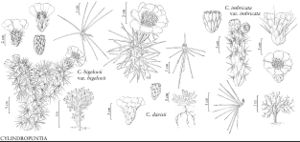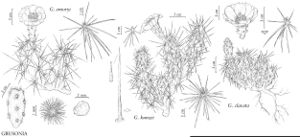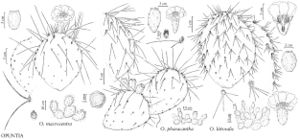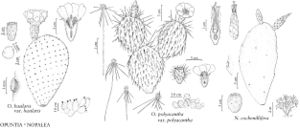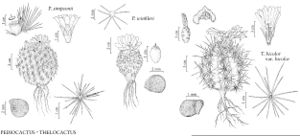Trees, shrubs, subshrubs, or somewhat vinelike, solitary to forming mats or clumps, terrestrial (sometimes deep-seated in substrate) to epiphytic or epipetric, erect to sprawling (rarely scrambling or climbing) or pendent in epiphytic or epipetric taxa, simple to many branched, usually stem succulent. Roots diffuse, taproots, or tuberlike, sometimes adventitious. Stems unsegmented or segmented, segments persistent to easily detachable; long-shoots spheric to depressed-spheric or club-shaped to long cylindric, or sometimes flattened cladodes, smooth, tuberculate and/or fluted with ribs; tubercles distinct as nipple-shaped or ridgelike (to triangular or pyramidal) protuberances to coalescent as vertical ribs; ribs 2–30 [–40+], if ribs 2, stems winged, if ribs 3 or more, stems ± angled; short-shoots (areoles) positioned on crests of ribs, at or near tubercle apices, or in axils of tubercles, commonly bearing persistent spines, also minute, barbed, deciduous spines (glochids) in subfam. Opuntioideae, and abundant, dense hairs (wool) creating a cushionlike appearance. Leaves deciduous to persistent, vestigial or absent, spirally alternate, sessile (petiolate to subsessile in Pereskia and several genera outside the flora), terete or flat, 0–3 cm (to 10 cm in Pereskia); stipules absent. Spines flexible and hairlike or bristlelike to rigid and needlelike or nail-like, terete to angled or flat, mostly hard (rarely corky or papery). Flowers bisexual (rarely unisexual or with bisexual and pistillate flowers on separate plants), nocturnal or diurnal, 1 (–several) per areole, arranged in true inflorescence only in subfam. Pereskioideae, or chains of fruits proliferating from fruit areoles (in Cylindropuntia fulgida), sessile (pedicellate in Pereskia), arising from stem areole at apex or axil of tubercle, radially symmetric [bilaterally symmetric]; flower tube 0.2–15 [–30] cm; perianth epigynous (perigynous in some Pereskia), deciduous or persistent on fruit; tepals 5–50 or more, intergrading gradually from bractlike or sepal-like outer tepals to petallike inner tepals; stamens usually 50–1500+ [sometimes fewer], decurrent on inner surface of flower tube; true ovary sunken in stem with tubercles present or absent, areoles conspicuous to obscure or absent; subtending scales persistent or deciduous, sometimes absent; spines present or absent, glochids present only in subfam. Opuntioideae; pistils compound, 1-locular; placentas parietal, 3–14 [–20+]; style 1; nectary usually forming chamber around base of style; stigma lobes 3–14 [–20+], 1 per placenta. Fruits basically berrylike (variable in succulence), deciduous or long persistent, indehiscent or dehiscent, succulent or leathery, sometimes promptly drying. Seeds (0–) 5–3000+, yellowish, reddish, brown, black, or appearing tan or whitish (dark testa completely covered by pale, tough, glabrous or rarely pubescent, tight-fitting aril or “funicular envelope” in subfam. Opuntioideae), pyriform, obovoid, lenticular-reniform, or nearly circular, 0.4–12 mm diam.; testa glossy or dull; rarely with corky arillate appendages (strophioles in Mammillaria tetrancistra). x = 11.
Distribution
Tropical to temperate regions in North America, West Indies, Central America, South America, including Galápagos Islands, Africa, Madagascar, Sri Lanka, widely naturalized in Old World tropics and subtropics
Discussion
Genera 125–130, species ca. 1800 (34 genera, 189 species in the flora).
The Cactaceae had a New World origin. Only Rhipsalis, a tropical, epiphytic “mistletoe cactus” with seeds dispersed by birds, has colonized forests of Africa, Madagascar, and Sri Lanka, apparently without human assistance. Other genera of cacti, especially Opuntia, have become naturalized in dry regions of Africa, Eurasia, and Australia, where they have been introduced for food, fodder, ornament, and the formerly very lucrative cochineal dye industry. In some places where they vegetatively clone, cacti have become weedy. A number of taxa throughout the New World have been used by humans in various ways for about 12,000 years (E. F. Anderson 2001).
The nomenclature and taxonomic circumscriptions presented here are based on recent, independent studies and differ significantly from the work of L. D. Benson (1982) and older publications. In particular, many taxa previously combined and recognized in the broad sense are now known as biologically distinct taxa, and other taxa appearing as sympatric “varieties” within species on Benson’s distribution maps have since been resolved either as fully isolated biological species or as misidentified or mismapped records of allopatric geographic taxa.
The family is now divided into four subfamilies (R. S. Wallace 1995; E. F. Anderson 2001). Three subfamilies occur in North America: Pereskioideae, Opuntioideae, and Cactoideae. The fourth subfamily, Maihuenioideae, is restricted to South America (Argentina and Chile).
The Cactaceae maintain an unusually complete representation of their phylogenetic history. Subfamily Pereskioideae, with the least-derived traits, consists of trees, shrubs, or scrambling “vines” with broad, seasonally deciduous leaves and terete stems that are only weakly succulent. As broad-leaved plants, their relationship to other cacti is not readily apparent, especially if flowers are absent. The succulent trees, shrubs, mat-forming subshrubs, and few geophytes of subfam. Opuntioideae have mostly very short-lived, terete, cylindric, or conic leaves, usually present only on young growth and flowers. Plants of subfam. Cactoideae have vestigial, usually minute (or absent) leaves and extremely succulent, spheric, barrel-shaped to columnar or snakelike stems. Similarly, flowers of Cactaceae range from the simple, radially symmetric, bee-pollinated flowers of most cacti to the elaborate, bilaterally symmetric, hummingbird-pollinated flowers of, e.g., Schlumbergera, the commercially grown “Christmas cactus” or “Easter cactus.” Funnelform bat-pollinated flowers also occur on some of the tallest cacti. The family ranges from extreme xerophytes in deserts to epiphytic mesophytes in rain forest, from sea level to about 4500 m (the altiplano of South American Andes), and from the equator to about 56º north latitude (Opuntia fragilis) and 50º latitude in the Southern Hemisphere (E. F. Anderson 2000). Whereas most cacti are terrestrial, in the tropics several genera are epiphytic on trees. A few tropical genera are also epipetric, and a number of xeric taxa may occur exclusively (or nearly so) in rock fissures.
Hybridization has been an influential force in the evolution of cacti. Many taxa and apparent taxa have their origins in hybridization, especially among the polyploid taxa. In North America, most polyploid cacti are taxa of Cylindropuntia, Opuntia, or Echinocereus.
The long shoots (main axis and branches) of cactus stems are succulent, ranging from hard and rigid to soft and marshmallow-like or watery inside. Surfaces of the long shoots may be smooth, ribbed (fluted), “winged” if the ribs are few, or covered with large tubercles. As used here, external ribs are not to be confused with the internal, long cylindric “ribs” or “rods” of wood, which correspond to the furrows between the external ribs. We will refer to only the external structures as ribs. In subfamily Cactoideae, the seedlings of some genera are tuberculate, even in genera with stems ribbed at maturity. Some phylogenetically transitional taxa, and individuals transitional between seedling and adult (reproductive) stages, exhibit every possible intermediate morphology with the tubercles coalescing into ribs, the ribs then interrupted or notched to various degrees. Further complicating identification in many taxa of subfamily Cactoideae, flowering may begin one or more seasons before attaining their adult stem morphology, e.g., bearing only tubercles instead of the ribs of adults. Stages of such plants have sometimes been misidentified and even named as new species. Some entire populations or taxa are neotenous, i.e., maintaining juvenile morphology throughout the life of the plant, and may look very different from their nearest kin.
Short shoots (areoles) are regularly spaced along the ribs or occur singly at the apices of the tubercles or in the axils of leaves. The areoles are woolly cushions with few to many spines (modified leaves of the shoot); spines are absent in some taxa, populations, and environments. A vernacular term for areoles is “spine-clusters,” but fertile areoles of adult cacti may contain additional meristematic regions, such as the areolar grooves of Coryphantha, from which flowers are produced. Photosynthetic leaves or bracts, when present, subtend the abaxial edges of areoles (one per areole). Areolar glands are extrafloral nectaries highly modified from greatly reduced spines. The glands, when present, usually occur toward the adaxial edges of areoles and appear domed or in some genera peglike. Glochids and hairlike spines are homologous transition-forms or “short-cuts” between normal spines, ontogenetically derived from short-shoot leaves, and normal hairs that are uniseriate proliferations of short-shoot epidermis.
Flower buds develop in the youngest areoles at the apex of the plant, or older areoles away from the apex, then often forming a ring around the apex. In most cacti, areoles are circular to oblong. In a few genera, they become elongate to hourglass-shaped: the vegetative, usually spiny, portions at tubercle apices and the reproductive (flowering or fruiting) portions in the axils of the tubercles—the two parts connected by a narrow, often fuzzy, groove on the adaxial side of the tubercle (e.g., Coryphantha). Several genera have a short groove or adaxial extension of the areole reaching only part way to the axil of the tubercle, with the flower produced at the adaxial end of the extension. In some genera (e.g., Mammillaria) the connecting groove is absent; the axillary reproductive regions are separate areoles distinct from the vegetative areoles.
In cactus flowers and fruits, the true ovaries are hidden in the tips of specialized long shoots, which strongly resemble inferior ovaries but often with areoles, spines, and/or bracts. In this treatment, “ovary” refers to the apparent inferior ovary—the proximal portion of the cactus flower that becomes the fruit. The fused stem ripens with the true ovary to become fruit wall.
The terms adaxial and abaxial in this treatment relate to the stem axis, especially when describing position within or adjacent to areoles. Virtually all other literature on Cactaceae uses the terms upper and lower, respectively.
Measurements apply to fresh or very well-preserved material. Flower colors are for fresh material. Shrinkage in dried specimens can be more than 50%. Stems of normally green species are often purplish or reddish under stress.
L. D. Benson (1982) reported that Rhipsalis baccifera (J. S. Müller) Stearn was “introduced or native” formerly in southern Florida on Cape Sable, east of Flamingo, and west of Kendall, and that the last individual was apparently destroyed by a hurricane in 1965. No more recent records have been located to indicate that the species is presently established in the flora. The species resembles mistletoe (Phoradendron) in habit (however, epiphytic not parasitic), stem diameter, and fruit size and color. The leafless areoles are minute, bearing hairlike spines; the flowers are rotate, translucent white, with very few tepals (ca. 7–10) and stigma lobes (ca. 3).
Selected References
Lower Taxa
Illustrations
Key
| 1 | Areoles with glochids deciduous to touch, persistent spines usually present; seed encased in hard, bony aril, whitish, tan, or brownish when dry, sometimes stained purplish or pink from juice of fruit [37b. Cactaceae subfam. Opuntioideae] | > 2 |
| 1 | Areoles without glochids, persistent spines present or uncommonly absent; seeds black or brown, never enclosed by any aril (large corky strophiole at one end of seed in Mammillaria tetrancistra) | > 6 |
| 2 | Stem segments cylindric to ± spheric; spines with epidermis separating completely or only at spine apex into thin, paperlike, tardily deciduous sheaths | > 3 |
| 2 | Stem segments bilaterally flattened, circular, ovate, or obovate, sometimes subcylindric or subspheric (rarely truly terete); spines without epidermal sheaths | > 4 |
| 3 | Plants small trees or shrubs (C. whipplei and perhaps others remaining low, forming mats or clumps in some populations); stem segments cylindric, sometimes ± slightly clavate; spine sheath deciduous for the length of spine, exposing whole spine, spines of various colors; major spines not or only basally angularly flattened; areoles on flowers and fruit bearing short feltlike wool | Cylindropuntia |
| 3 | Plants low, forming mats or clumps (G. kunzei somewhat taller); stem segments cylindric-clavate and usually upturned from base to ± spheric; spine sheath deciduous only at spine apex, exposing yellow spine tip; at least one of largest spines in distal areoles angular-flattened to ribbonlike; areoles on flowers and fruit bearing long tufts of wool | Grusonia |
| 4 | Nectar chamber (as seen in longitudinal section of flower) open, not covered by proximal thickening of style (style often swollen at base and ± pyriform); fruits terete, straight; main axis of plant determinate, segmented; widespread in North America | Opuntia |
| 4 | Nectar chamber covered by extended proximal thickening of style; fruits either terete or bilaterally flattened near base, straight or curved; main axis of plant either determinate and segmented or indeterminate and unsegmented; native to or naturalized in Florida | > 5 |
| 5 | Tepals erect, closely enclosing proximal portion of much-exserted stamens and style; fruits spineless, terete, straight; main axis of plant determinate, segmented; naturalized | Nopalea |
| 5 | Tepals spreading; stamens and style not exserted or slightly so; fruits spiny, terete or flattened near base (oval in cross section), often curved; main axis of plant indeterminate, unsegmented; rare native | Consolea |
| 6 | Photosynthetic stem leaves broad, flat, pinnately veined, deciduous, conspicuous at least on new growth, more than 10 mm wide; broad leaflike bracts present on ovary [37a. Cactaceae subfam. Pereskioideae] | Pereskia |
| 6 | Photosynthetic stem leaves absent or rudimentary, usually less than 1 mm; triangular ± leaflike bracts or small scales sometimes present on ovary and flower tube (Epiphyllum has photosynthetic stems sometimes resembling leaves but with areoles along margins) [37c. Cactaceae subfam. Cactoideae] | > 7 |
| 7 | Stems 2-ribbed or, on proximal portion or juvenile stems, 3-ribbed, flattened distally, leaflike, stem areoles at margins, lacking stiff spines, fine, hairlike bristles sometimes present | Epiphyllum |
| 7 | Stems 3-5- to many-winged, -ribbed (fluted), -angled, or tuberculate or terete, stem areoles along crests of wings, ribs, or angles or at apex of tubercles or on surface of terete stems, usually spiny, or if spines absent or only hairlike bristles present, then plants 4-many-ribbed or tuberculate | > 8 |
| 8 | Stems scandent, scrambling, trailing, pendent, or arching, ribbed; ribs 3-12, rounded, winglike, or sharp-angled | > 9 |
| 8 | Stems (at least the branches) usually erect or ascending, or spheric to top-shaped and deep-seated in substrate, tuberculate or ribbed; ribs 5-many, or if ribs 4 then plants erect or deep-seated in substrate | > 13 |
| 9 | Spines of stems hard, conic, 1-10 mm or soft, bristlelike, 4.5-15 mm; plants usually epipetric or epiphytic, freely producing adventitious roots | > 10 |
| 9 | Spines of stems ± hard, acicular, 10-40 mm (2-9 mm and acicular in E. poselgeri); plants terrestrial, not usually producing adventitious roots | > 11 |
| 10 | Stems usually 3-ribbed, 4-7.5 cm diam.; fruits spineless; scales large, triangu- lar, protruding conspicuously from fruit, to 4 cm, axils naked | Hylocereus |
| 10 | Stems usually 4-8-ribbed, 0.8-5 cm diam.; fruits spiny, spines usually flexible, hairlike; scales, if present, minute, not conspicuous, not protruding from fruit | Selenicereus |
| 11 | Stems 20-130 × 0.6-15 cm; flowers 35-120 mm, diurnal; inner tepals often pink, magenta, or red; species of grasslands, mesquite woodlands, Tamaulipan thorn scrub, Chihuahuan desert scrub, Texas westward | Echinocereus |
| 11 | Stems 200-700 × (4-)6-8 cm; flowers 140-400 mm, nocturnal but remaining open next day; inner tepals white or pink; species of Tamaulipan thorn scrub or Caribbean tropical forests, Texas and Florida | > 12 |
| 12 | Stems cylindric, 8-12-ribbed; ribs not winglike, less than 1 cm deep (from rib’s base to crest), nearly as broad as deep; areoles usually spaced less than 2.5 cm apart along ribs; areoles of flowers bearing long hairs | Harrisia |
| 12 | Stems angled, deeply 3-5-ribbed; ribs winglike, 3-5 cm deep (from rib’s base to crest), less than 1 cm thick; areoles widely spaced, 2-5 cm apart along ribs; areoles of flowers bearing spines and short wool | Acanthocereus |
| 13 | Spines or bristles absent from all areoles of stem | > 14 |
| 13 | Spines or bristles present in all or most areoles of stem | > 16 |
| 14 | Scales of flower and fruit spine-tipped, subtending soft, white, axillary hairs; stems speckled by dense tufts of whitish hairs; inner tepals yellow, proximally red | Astrophytum |
| 14 | Scales of flower and fruit bluntly tipped or absent, if present their axils naked; stems ± uniformly colored, not speckled white; inner tepals white, yellowish white, pink, or magenta | > 15 |
| 15 | Stems strongly tuberculate, tubercles hard, fissured, ± triangular, arranged in compact rosettes or mosaics | Ariocarpus |
| 15 | Stems ribbed or weakly tuberculate, ribs or tubercles soft, smooth, low, broadly rounded | Lophophora |
| 16 | Flowers and fruits bearing stiff (sometimes ± flexible), sharp-tipped spines (not to be confused with spine-tipped scales) from all or most areoles, spine clusters slowly deciduous from ripe fruit in some genera | > 17 |
| 16 | Flowers and fruits naked or bearing soft trichomes or hairlike spines from all areoles or axils of scales, stiff spines absent (spine-tipped scales on flowers and fruits of Echinocactus) | > 21 |
| 17 | Stems less than 2 cm diam., ribs 4-9; roots turnip-shaped or tuberlike | Peniocereus |
| 17 | Stems more than 4 cm diam. (or if less, then ribs more than 9); roots diffuse (tuberlike in Echinocereus poselgeri) | > 18 |
| 18 | Spines 30-45 per areole, straw yellow; inner tepals yellow; plants form- ing thickets; coastal s California | Bergerocactus |
| 18 | Spines (0-)2-28 per areole, various colors including yellow; inner tepals white to red, or yellow; plants unbranched to many branched and forming clumps; widespread, California deserts to Texas, northward | > 19 |
| 19 | Inner tepals pink to red, and/or yellow; plants less than 40 cm at reproductive age | Echinocereus |
| 19 | Inner tepals white; plants more than 100 cm at reproductive age | > 20 |
| 20 | Plants mostly branched from base; stems 11-18 cm diam.; flow- ers 6-7.5 cm; ovary with stiff spines | Stenocereus |
| 20 | Plants mostly branched near midstem; stems 25-75 cm diam.; flowers 8.5-14 cm; ovary spineless or with few bristlelike spines | Carnegiea |
| 21 | Largest spines conspicuously annulate-ridged; flowering plants less than 150(-300) cm | > 22 |
| 21 | Largest spines not annulate-ridged; flowering plants usually more than 300 cm | > 23 |
| 22 | Scales of ovary and flower tube spine-tipped, axils woolly, wool hiding flower tube and ovary at anthesis | Echinocactus |
| 22 | Scales of ovary and flower tube obtuse, axils naked, scaly flower tube and ovary exposed at anthesis | Ferocactus |
| 23 | Stems at least 200 cm at reproductive age, columnar; inner tepals white (or pink in Pachycereus) | > 24 |
| 23 | Stems less than 100 cm, usually barrel-shaped, spheric, or short columnar; inner tepals commonly cream to pink, magenta, yellow, or dark maroon, or if white then stems less than 30 cm | > 27 |
| 24 | Stems 2.5-8 cm diam.; flower tubes bearing areoles and long, conspicuous hairs, 6-15 mm, or areoles absent or nearly so; s Florida | > 25 |
| 24 | Stems 12-75 cm diam.; flower tubes bearing numerous areoles with scales and perhaps short wool less than 2 mm; Arizona and easternmost California | > 26 |
| 25 | Flowers 12-20 cm; areoles of ovary and flower tube bearing long conspicuous hairs; old plants with branches usually ascending, prostrate, or clambering, not commonly erect, crown nonexistent | Harrisia |
| 25 | Flowers 5-6 cm; areoles absent from ovary and flower tube or nearly so, if few present then with short wool; old plants with closely parallel, erect branches forming narrow crown | Pilosocereus |
| 26 | Flowering region of stems 25-75 cm diam.; flowering areoles of stems bear- ing hard, rigid, spines; ribs 19-26 | Carnegiea |
| 26 | Flowering region of stems 12-16 cm diam.; flowering areoles of stems bear- ing long, flexible, wiry, bristles; ribs 4-7 | Pachycereus |
| 27 | At least some spines hooked in all or most mature areoles (i.e., near tops of plants) | > 28 |
| 27 | Spines all straight or curved (if uncertain take this lead) | > 36 |
| 28 | Three abaxial (lower) radial spines hooked and 1 hooked central spine per areole; inner tepals brick red or maroon | Glandulicactus |
| 28 | All radial spines straight or gradually curved and 1 or more hooked central spines per areole; inner tepals white, yellow, pink, red to maroon, brown, or green | > 29 |
| 29 | Stems tuberculate, tubercles not proximally confluent, forming ribs; flowers axillary: borne deep in axils of distinct tubercles not arranged as ribs | > 30 |
| 29 | Stems ribbed, ribs often strongly tuberculate (immature plants, sometimes flowering, may have tubercles not confluent into ribs); flowers not truly axillary: borne at adaxial edge of spine-bearing areoles, or in "notches" of ribs at adaxial end of broad "groove" extending from spine cluster (vegetative portion of areole) | > 32 |
| 30 | Adaxial (uppermost) central spines distinctly flat | Ancistrocactus |
| 30 | Adaxial (uppermost) central spines terete | > 31 |
| 31 | Flowers borne at stem apex (fruits may be displaced from stem apex by growth of new tubercles after flowering), in axillary end of narrow, linear, areolar groove extending along adaxial surface of tubercle from spine-cluster (vegetative portion of areole) to tubercle axil; glands present or absent in mature areoles of stem; fruits (35-)42-50 mm; longest central spines, when present, 23-34 mm | Coryphantha |
| 31 | Flowers borne remote from stem apex, forming a ring of flowers around stem; glands absent from mature areoles of stem; fruits 5-30(-40) mm; central spines less than 20 mm [except to 25(-31) mm in M. grahamii, M. tetrancistra, and M. viridiflora] | Mammillaria |
| 32 | Central spine 1 per areole, terete, hooked | > 33 |
| 32 | Central spines 1-8, 1 or more flat, 1 or more hooked | > 34 |
| 33 | Longest spines 7-15 mm; inner tepals white, yellow, or pink to purplish, often with dark midstripes; fruits tan, green, pink, or reddish; California to Texas north to Nevada, Utah, and Colorado | Sclerocactus |
| 33 | Longest spines 12-38 mm; inner tepals yellow with red basal portions; fruit bright red; Texas | Hamatocactus |
| 34 | Flowers 5.5-8.5(-10) cm; stigma lobes 13-20, 7.5-15 mm; cortex and pith firm, not mucilaginous; seeds pitted | Ferocactus |
| 34 | Flowers less than 4 cm or if longer then plants not of Texas or s New Mexico; stigma lobes 4-12, 1.5-3.5 mm; cortex and pith mucilaginous; seeds papillate or minutely so | > 35 |
| 35 | Fruits indehiscent, green, sometimes suffused pink or brownish purple, drying yellowish, tan, or white, scaly; glands present in adaxial extension of mature stem areoles; Texas and s New Mexico | Ancistrocactus |
| 35 | Fruits dehiscent along 2-4 irregular, short vertical slits above base, or sheering along nearly circular region of deliquescence at base, green, often turning red, naked or with few scales; glands of stem areoles absent; widespread: California to Texas north to Nevada, Utah, and Colorado | Sclerocactus |
| 36 | Stems ribbed, tubercles, when present, confluent into ribs | > 37 |
| 36 | Stems tuberculate, tubercles not confluent into ribs | > 38 |
| 37 | Flowers borne in adaxial ends of areolar grooves, occupying and greatly distorting most of groove | Echinomastus |
| 37 | Flowers borne in short extension of spine-bearing areoles, near spines | Sclerocactus |
| 38 | Flowers and fruits arising from axils of tubercles | > 39 |
| 38 | Flowers and fruits arising from adaxial edge of spine-bearing areoles, either immediately adjacent to spine cluster or slightly away from spine cluster in short, wooly, areolar extension | > 42 |
| 39 | Flowers and fruits distant from apex of plant, forming ring around stem; flowers arising from distinct areoles in axils of tubercles; flowering areoles not con- nected to vegetative (spiny) areoles by areolar groove | Mammillaria |
| 39 | Flowers apical on plant (except in Coryphantha recurvata), fruits apical or displaced away from apex by development of new tubercles after flowering; flowers arising from adaxial end of narrow, linear, areolar groove extending from vegetative (spiny) areole at tubercle apex along adaxial side of tubercle to axil of tubercle | > 40 |
| 40 | Ovary usually scaly, scales 1-20(-34), broad, scarious | Echinomastus |
| 40 | Ovary normally lacking scales (rarely with 1-2 small scales) | > 41 |
| 41 | Tubercles distinct; fruits indehiscent, usually juicy (soon drying in some species), green or red when ripe, ellipsoid, 1.5-60 × 1.5-20 mm; floral remnant persistent or deciduous; seeds smooth, raised-reticulate or pitted | Coryphantha |
| 41 | Tubercles tightly packed in vertical or nearly vertical, spiraling rows resembling tuberculate ribs; fruits inconspicuously dehiscing by vertical slits, dry, green to white, becoming tan or greenish brown, spheric, 4-10 × 4-8 mm; floral remnant deciduous; seeds papillate. | Neolloydia |
| 42 | Spines numerous, 20-90 per areole, minute, 4.5-12 mm at stem apex, shorter from breakage or wear, white to ashy gray, completely hiding stem surface; fruits narrowly cylindric, bright red, indehiscent; Arizona, New Mexico, Texas | Epithelantha |
| 42 | Spines fewer, 3-45 per areole, or if more than 20 then spines not at all hiding stem surface or either darkly colored or flexible and hairlike or flat and ribbonlike; fruits cylindric to spheric or turbinate, green to red, often dull reddish, dehiscent at basal pore or along 1-3 vertical lines; widespread in w United States from extreme s and w Texas to n Arizona and northward to Idaho, Montana, and South Dakota | > 43 |
| 43 | Spines terete, at most slightly elliptic in cross section, needlelike, hairlike, or thick and corky | Pediocactus |
| 43 | Spines, at least some in most mature areoles, clearly flattened or angular-flattened | > 44 |
| 44 | Central spine(s) flat, thin, often papery or, if central spine absent, then radial spines strongly flattened; flowers usually less than 4 cm, campanulate to funnelform, usually less than stem diam. (except in smallest plants); inner tepals erect to ascending (spreading in S. polyancistrus of California and Nevada), cream, yellow, pink, purple, or lavender, sometimes with brownish midstripes; cortex mucilaginous; extreme w Texas northwestward | Sclerocactus |
| 44 | Central spines terete, flattened, or angled; adaxial radial spines flat and bladelike or ribbonlike; flowers 4 cm or more, funnelform, diam. often equaling or exceeding stem diam.; inner tepals widely spreading, magenta or pink; cortex not mucilaginous; s Texas | Thelocactus |

